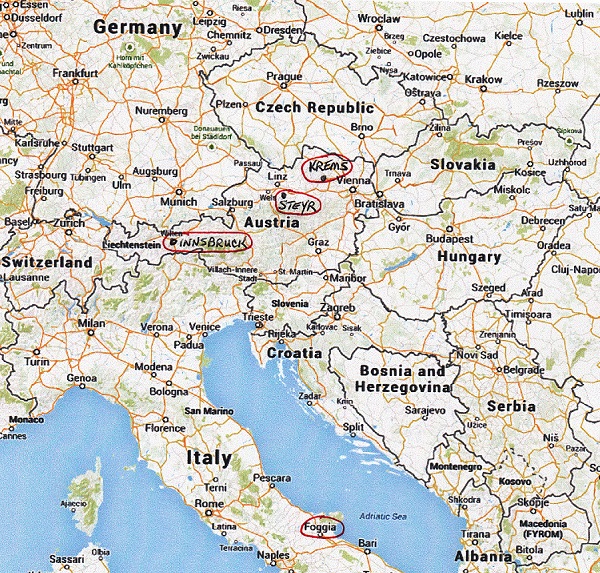Robert Nori
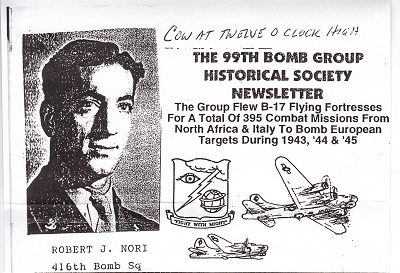
Image courtesy Maryann Ward Downs
Most of the information on this page came from Cousin Maryann Ward Downs. The following is a letter that Bob wrote to the 99th Bomb Group Historical Society Newsletter detailing his experiences. The photos are from Google Images.
In one of the 99th Bomb Group newsletters, it was noted that on April 2, 1944, two aircraft failed to return from their mission to Steyr, Austria. One of the planes was commanded by Lt. Joe Moffitt.
My name is Robert Nori and I was the radio operator of that crew and I wish to relate what happened that fateful day.
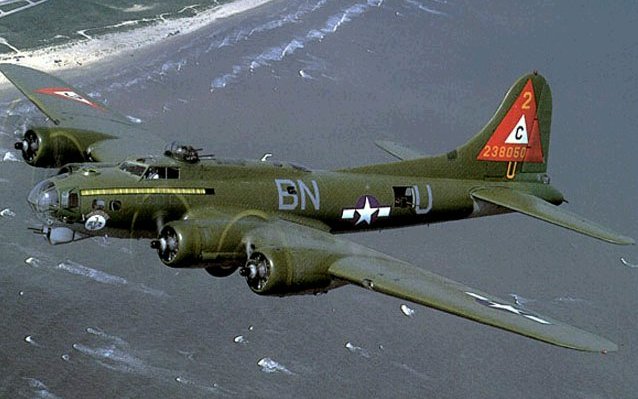
A few minutes later, the #2 engine had to be feathered. We threw out everything that we could to lighten the load. There was discussion about heading to Switzerland, but we felt the B17 could get us back to Foggia on two engines, or at worst ditch in the Adriatic.
We were over Yugoslavia when the #4 engine had to be feathered. We decided against bailing out because we felt we had the two best pilots that ever flew a B17, in command, Joe Moffitt and Vern Baldwin, but even they couldn’t keep the stricken plane in the air, and we crash landed in a plowed field at the base of the hills. The landing was smooth and no one was hurt. We destroyed the bombsight, IFF, radio equipment and either burned out the barrels of the guns or stripped them.
We left the plane and climbed to the top of the hill. Taking rifle fire from soldiers of a nearby village, we broke up into three groups.
Lester Malone, ball gunner, Bill Dailey, tail gunner, a replacement bombardier and myself were captured soon after. Joe Moffitt, pilot, John Guldan, navigator and Ed Barker, gunner, were captured the next day. Vern Baldwin, co-pilot, Frank Kramer, engineer, and Gene Fast, replacement gunner, evaded capture, and made contact with Tito’s Headquarters. They returned to Foggia and completed their missions. As did Roy Horton, original engineer, who was not on this mission.
Following our capture, we were exposed to the standard interrogation; you know, name, rank and shoe size. A few days later, the non-coms were boxcarred to Stalag 17 at Krems, Austria.
Upon arrival, the GI’s gave us a bowl of soup. I saw things squirming in it, removed the squirming things and drank the soup. A few days later, if those squirmy things tried getting out, I would push them back in the bowl.
Life at Stalag 17 was without heat in the winter and two men fully clothed slept together under two flimsy blankets to keep warm. In order to help end the monotony, one GI would offer classes in electrical wiring, another in plumbing and we often arranged pinochle tournaments and such.
Food was scarce and the Red Cross parcels we received the first few months helped somewhat, but that stopped as the German railroads were bombed. Actually, as a Brooklyn boy who came from a family of 8 children that survived the depression, I was accustomed to missing a meal or two, so I was able to survive better than others, and even so, I lost a lot of weight.
Christmas Eve ’44 and barracks 32 of Stalag 17 put on a Christmas show. The barracks were jammed to the rafters with GI’s and the German brass had the front row. I was in, of all things, a restaurant skit. Myself and another fellow named Fogelman played customers and Ed Trzcinski (who later co-authored the Broadway play and movie “Stalag 17”), played the waiter. There were some corny jokes that got some laughs and as I exited the stage, I gave my best imitation of the Groucho Marx walk, which also got a laugh.
At the end of the show, both GI’s and Germans sang “Silent Night” together.
As the Russians entered Vienna to the East, anyone who could walk was ordered on the road heading West toward the American lines. At night, we either slept in a barn or on the ground. After a number of days marching, we were left to make do in a forest across the river from the town of Innsbruck. There were some farms nearby, and with the little German I had learned, tried to ask for some food. The farmers knew the war was almost over and they did help. Many GI’s suffered with dysentery and it was a bad time.
After a week in the forest, General Patton’s troops liberated us and took us to a bombed out factory where a kitchen was set up. We thought white bread tasted as good as any cake, although not having had rich food in such a long time, it took a while before we could keep it down.
We were airlifted to Le Havre in France, where we boarded a ship for home after VE day. My thirteen months in captivity was over.
One thing that stands out in my mind was the camaraderie of the American servicemen working together to overcome hardship and survive at all. I was proud to be a part of that. As for me, I was elated to hear that all ten of my crew returned home without injury.
Robert Nori
99th BG
416 SQDN
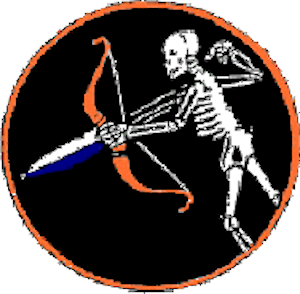
Bob was captured and sent to Stalag 17 following the crash landing on April 2 of 1944. Two months later, while he was being held at the POW camp, a small news item appeared in the Brooklyn Eagle newspaper. The date of the article was June 6, 1944, the date for the start of the huge military invasion of Europe by the Allies that became known as D-Day.
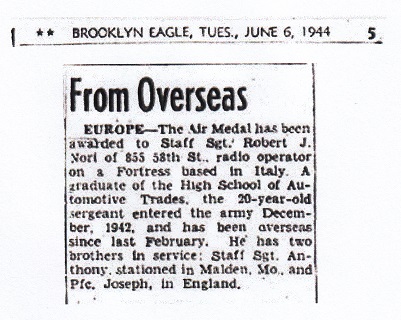
The Austrian town of Krems, where Stalag 17 was located, lies 90 miles east of Steyr, Austria, the target of the B17's bombing mission. Krems is also 50 miles west of Vienna. The plane was on its way back to the air base in Foggia, Italy when it crashed somewhere in Yugoslavia, probably in what is now known as Slovenia or Croatia. When Bob and the others were moved out of the POW camp in early 1945, they made their way on foot for 280 miles to Innsbruck. V-E Day was May 8, 1945.
